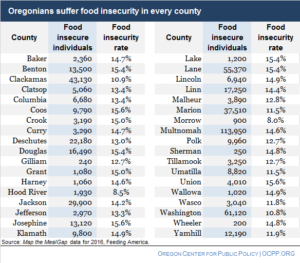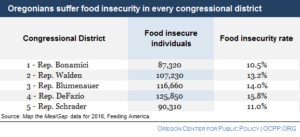Read the full report as a PDF: Oregonians in Every County and Congressional District Suffer Food Insecurity
Despite a strengthening job market, Oregonians in every corner of the state struggle to put food on the table. Their challenges will become more severe, should Congress enact cuts to the Supplemental Nutrition Assistance Program (SNAP), the nation’s first line of defense against food insecurity.
Food insecurity afflicts Oregonians in every part of the state
Oregonians across the state are having trouble getting enough food for an active, healthy life. Food insecurity means not having access to adequate nutrition.[1] In 2016, more than a half a million Oregonians suffered from food insecurity.[2]
More than one in 13 people in every county and congressional district in Oregon struggle to put food on the table.[3] In 2016, food insecurity rates ranged from 8 percent in Morrow County to 15.6 percent in Union County, and from 10.5 percent in Congressional District 1 (U.S. Representative Suzanne Bonamici’s district) to 15.8 percent in Congressional District 4 (U.S. Representative Peter DeFazio’s district).

See the county fact sheets for more information.

See the congressional district fact sheets for more information.
Food insecurity harms mental and physical health at all ages
Inadequate nutrition undermines a person’s physical and mental health. Food insecurity is associated with a host of acute and chronic health conditions in adults, such as arthritis, asthma, cancer, kidney disease, heart disease, diabetes, hepatitis, hypertension, obesity, insufficient sleep, and stroke.[4] It is also associated with mental health conditions such as depression, mental distress, and suicidal thoughts. Older adults can experience greater incidence of congestive heart failure, gum disease, lower cognitive function, and osteoporosis.
Food insecurity is particularly detrimental to children. Common physical conditions associated with food insecurity among children include asthma, birth defects, anemia, low birth weight, lower bone density, lower physical functioning, colds, stomachaches, and tooth decay.[5] Children can also experience mental and behavioral issues, such as hyperactivity, developmental delays, depression, anxiety, and suicidal thoughts. Unsurprisingly, children lacking adequate nutrition do not do as well in school as children who are food secure.
SNAP helps Oregonians throughout the state get enough to eat
The federal Supplemental Nutrition Assistance Program (SNAP) is Oregon’s most powerful tool in the battle against food insecurity. SNAP (formerly called food stamps) provides benefits to low-income households that can only be spent on food. SNAP is also a key work support because it helps to fill a basic need for people finding and keeping work.
The program is well-targeted, offering the most assistance to those with the lowest income. In Oregon, a household of three can receive assistance until their income exceeds about $38,000 per year.[6] Unless the economy is weak and jobs are scarce, adults without dependents can receive assistance for only three months in a three-year period, unless they are working at least 20 hours per week or are in a job training program.[7]
SNAP is effective. Research shows that, among households with children that sign up for the program, SNAP reduces food insecurity by as much as 31 percent.[8]
Cuts to SNAP would increase food insecurity in Oregon
For families that qualify for federal food assistance, life could get more difficult if Congress enacts provisions in the Farm Bill that undermine SNAP.[9]
A version of the Farm Bill that recently failed in the U.S. House of Representatives would have cut SNAP for Oregonians currently eligible for assistance. The proposal would have made SNAP’s work requirements harsher by applying them to older working-age adults and adults raising school-age children, and cutting people from food assistance for one to three years if they are unable to prove on a monthly basis compliance with work requirements.[10] Such a policy would be particularly difficult for workers in low-wage industries where irregular scheduling and job instability are common. The bill would also have made SNAP unavailable to working families who face high living expenses. Additionally, the bill would also have layered on inefficient paperwork requirements that do not increase employment but simply become barriers for people barely making ends meet.[11]
The threat to SNAP is not over. It is expected that other draconian SNAP proposals will emerge in Congress in the coming days and weeks.
Conclusion
Food insecurity afflicts Oregonians in every corner of our state, and the problem would worsen if Congress follows through with cuts to the nation’s most important anti-hunger defense, the Supplemental Nutrition Assistance Program. Every member of Oregon’s congressional delegation ought to oppose any weakening of SNAP. Instead, they should strengthen SNAP’s ability to reach households struggling to put food on the table.
[1]In this fact sheet, “food insecurity” figures refer to survey data collected by the U.S. Department of Agriculture labeled “low food security” and “very low food security.” Food Security in the U.S.; Measurement, Economic Research Service, U.S. Department of Agriculture.
[2]Oregon Lags in Fighting Food Insecurity, OCPP, May 17, 2018.
[3]C. Gundersen, A. Dewey, A. Crumbaugh, M. Kato, and E. Engelhard, Map the Meal Gap 2018: A Report on County and Congressional District Food Insecurity and County Food Cost in the United States in 2016, Feeding America, 2018.
[4]A summary of the extensive research on the impact of food insecurity is contained in The Impact of Poverty, Food Insecurity, and Poor Nutrition on Health and Well-Being, Food Research Action Center, December 2017.
[5]Ibid.
[6]Oregon’s income limit for SNAP eligibility is 185 percent of the federal poverty level.
[7]Current SNAP work requirements apply to adults up to age 49 without dependents.
[8]OCPP analysis of research of James Mabli, Jim Ohls, Lisa Dragoset, Laura Castner, and Betsy Santos, Measuring the Effect of Supplemental Nutrition Assistance Program (SNAP) Participation on Food Security, Prepared by Mathematica Policy Research for the U.S. Department of Agriculture, August 2013; also Caroline Ratcliffe and Signe-Mary McKernan, How Much Does SNAP Reduce Food Insecurity? Urban Institute, March 2010.
[9]The Farm Bill is federal legislation Congress approves approximately every five years that includes agricultural and nutrition programs.
[10]The bill would extend SNAP’s current provision that the work requirement can be fulfilled through participation in work training programs; however, the funding provided would be wholly inadequate for those at risk of losing assistance. House Agriculture Committee’s Farm Bill Would Increase Food Insecurity and Hardship, Center on Budget and Policy Priorities, page 3, May 10, 2018.
[11]House Agriculture Committee’s Farm Bill Would Increase Food Insecurity and Hardship, Center on Budget and Policy Priorities, May 10, 2018.








